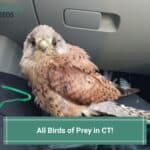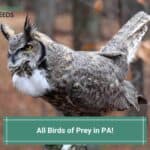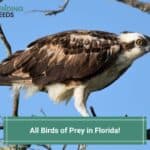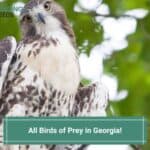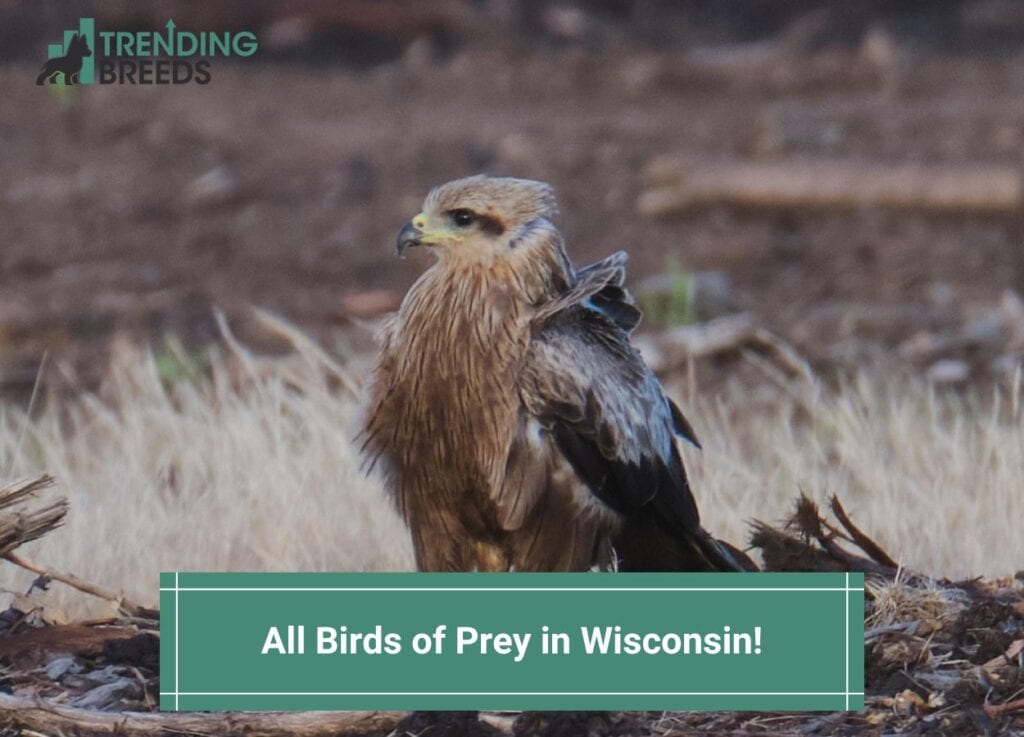
Are you interested in learning about birds of prey in Wisconsin?
Birds of prey, carnivorous birds that hunt or scavenge birds, fish, mammals, and insects, are majestic creatures in all shapes and sizes.
From the brightly colored American Kestrel to the mighty Bald Eagle, Wisconsin is home to a diverse array of raptors.
Wisconsin is located on the shore, so it attracts a variety of fish-eating falcons, hawks, and birds.
Moreover, the state also attracts birds that don’t mind the extreme and constant fluctuations in weather and temperature.
Safe to say, Wisconsin is home to various beautiful and wild birds. To dive deeper into the subject, here are some of the 13 most commonly found birds of prey in the state:
Before you scroll further down this guide, check out these other animal-related articles: Best Vizsla Breeders in Wisconsin and Best Cavapoo Breeders In Wisconsin.
Table of Contents
1. Black-Crowned Night-Heron
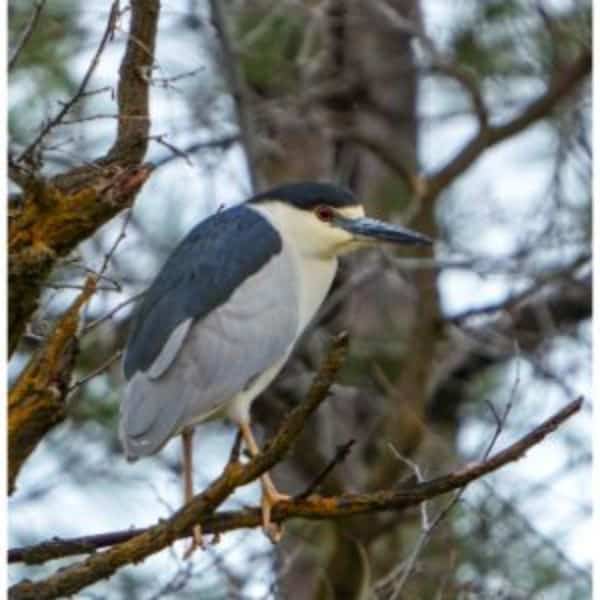
Black-Crowned Night-Heron Characteristics:
- Scientific Name: Nycticorax nycticorax
- Size: 58-64 cm
- Weight: 625-800 grams
- Wingspan: 105-115 cm
- Life span: 20 years
- Conservation Status: Least Concern
Marshes all over North America are home to numerous Black-Crowned Night-Herons.
Black-Crowned Night-Herons are small raptors. Adults have a black back, and the rest of their bodies are grey or white.
Their eyes are red, and their heads are bigger than their bodies.
They also have a long, sharp black beak. Their wings are curving and broad, and their legs are short. The legs hardly reach the tail’s end when they are flying.
Black-Crowned Night-Herons spend most of the night scavenging. The herons typically spend the day cuddling up amid the trees near the shore.
Numerous threats are causing the Black-Crowned Night-Heron population to decline.
Degradation of the aquatic environment and environmental contamination are two of these risks.
2. Red-Shouldered Hawk
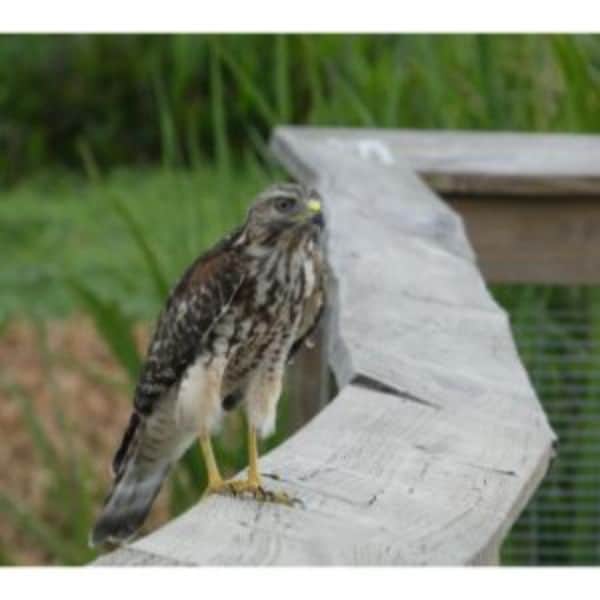
Red-Shouldered Hawk Characteristics:
- Scientific Name: Buteo lineatus
- Size: 43-61 cm
- Weight: 550-1,000 grams
- Wingspan: 90-127 cm
- Life span: 0-15 years
- Conservation Status: Least Concern
In wetland woods around the state, this strikingly marked Buteo can be heard making its distinctive whistle sound.
The underparts of Red-shouldered Hawks are rufous-peach barred, while their backs are a mottled mixture of black and white with rufous “shoulders.”
The wingtips are squarish as opposed to the spread fingers of other Buteos, and both the flight feathers and tail are banded.
All Red-shouldered Hawks display translucent white crescent-shaped structures on their wingtips, regardless of age, while in flight.
The “limbs” and reddish-brown bodies are visible from below. Thanks to their long tails, they have a neater flight silhouette than other Buteos.
Red-shouldered Hawks can flail their wings before gliding, giving them the appearance of an Accipiter and keeping the broad-winged Buteo appearance.
The hawk’s diet includes lizards, amphibians, small birds, and snakes.
They occasionally grab birds from feeders, but other birds are not their main food source.
Nests are typically found in a tree branch, slightly higher than the ground, and frequently next to a body of water.
Year after year, they will utilize the same nest, rebuilding it with leaves, grass, and twigs from conifers.
3. Short-Eared Owl
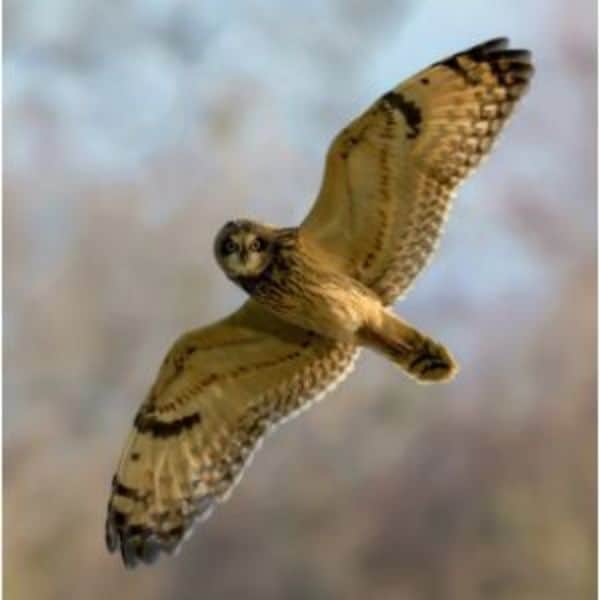
Short-Eared Owl Characteristics:
- Scientific Name: Asio flammeus
- Size: 34-43 cm
- Weight: 206-475 grams
- Wingspan: 85-110 cm
- Life span: 3-5 years
- Conservation Status: Least Concern
One of the most common owls in Wisconsin is the Short-eared Owl.
They catch prey by making use of their exceptional flight ability. But they also utilize it for long-distance flights.
In a single migratory season, Short-eared Owls have been seen to fly more than 1,200 miles away.
Sadly, in recent years, their population has drastically decreased. However, their conservation status remains the least concern for now.
Typically, Short-eared Owls have a huge head, wide eyes, and broad wings. They have black bills that are tiny, strong, and hooked.
Their color ranges from speckled to brownish-orange, and the ends of their wings and tails are banded. Moreover, the owl has a light face and vivid, black-lined eyes.
Short-eared Owls are among the rare subspecies of owls constructing their nests on the ground. A stand of trees or other plant life conceals the nest.
Short-eared Owls thrive in grasslands, deserts, wetlands, and tundra.
They can be spotted in open regions with many rats and mice during the breeding season. In the winter, they were also visible in areas with shrubs.
4. Cooper’s Hawk
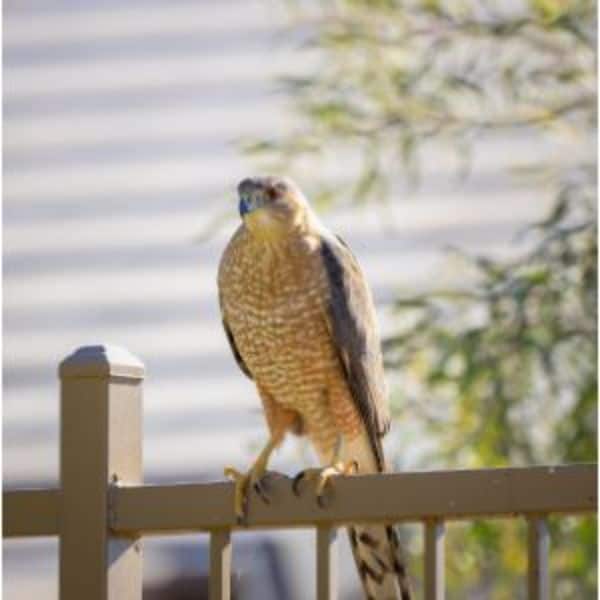
Cooper’s Hawk Characteristics:
- Scientific Name: Accipiter cooperii
- Size: 35-46 cm
- Weight: 300-550 grams
- Wingspan: 61-94 cm
- Life span: 5-12 years
- Conservation Status: Least Concern
The next one on our list of birds of prey in Wisconsin is the Cooper’s Hawk. As hawks are renowned for being mute, don’t try to identify this bird of prey by its call.
You’ll have better luck spotting a Cooper’s Hawk by its warm red feathers enveloping its bellies and steel blue wings.
The Cooper’s Hawk is a medium-sized hawk; it is about the size of a crow, and the females are often larger than the males.
One of the best chances to view Cooper’s hawk flying overhead is during their autumn migration, which starts around October and takes them south for the winter.
The greatest area to see Cooper’s Hawk in Wisconsin will depend on what time of year you visit.
You have a better chance of spotting one in the northern part of the country during the summer, and you have a better chance of spotting one in the southern parts if you go during the fall.
They are indigenous to northern America and are listed by the IUCN as least concern with a warning about population growth.
5. Swainson’s Hawk
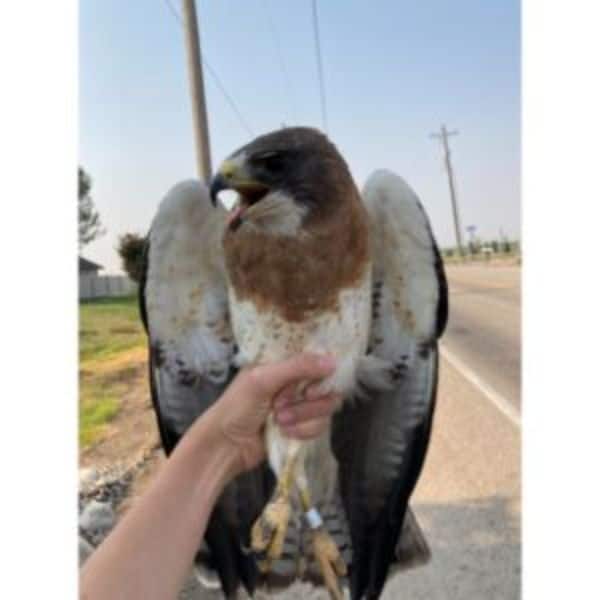
Swainson’s Hawk Characteristics:
- Scientific Name: Buteo swainsoni
- Size: 46-56 cm
- Weight: 610-1,110 grams
- Wingspan: 117-137 cm
- Life span: 7-10 years
- Conservation Status: Least Concern
Swainson’s Hawks are huge, distinguishable by their long wings and short tails.
Most of Swainson’s Hawks have bright white feathers covering their bellies and dark feathers on their backs and wings.
Regional variations have, however, demonstrated that these hawks can exhibit significant color diversity.
Swainson’s Hawks spend the summer months in open areas and build their nests in grasslands. They devote a lot of time waiting for food on high perches.
The Swainson’s Hawk’s ecology is not well understood.
They are frequently observed in Wisconsin during their annual migration, which takes place in October and is a popular season for well-known hawk-viewing locations.
Although it’s quite uncommon to see a Swainson’s Hawk in Wisconsin, if you’re passionate about finding one, your best bet would be to look in the eastern and southern-eastern parts of the state.
They frequently engage in a loop-and-dive ritual for courting in these places over wide-open grasslands.
6. Northern Goshawk

Northern Goshawk Characteristics:
- Scientific Name: Accipiter gentilis
- Size: 48-69 cm
- Weight: 630-1,450 grams
- Wingspan: 94-127 cm
- Life span: 8-15 years
- Conservation Status: Least Concern
A Northern Goshawk is a hawk with goose-sized wings and a light gray underside. Similar to other hawk species, females are bigger than males.
Goshawk juveniles have striations of brown feathers on their chest and wings. These hawks live and breed in forests, primarily coniferous ones.
The Northern Goshawk is best observed from a distance because it is aggressive toward people and is fiercely protective of its nests.
When danger is imminent, they use a ‘ki-ki-ki’-like alert that they have. The northern parts of Wisconsin are the finest locations to attempt to spot one of these hawks.
A few regions have been discovered in the state’s center region over plantations of pins, but this is more uncommon.
In forests, their nests are typically found in coniferous trees.
The greatest time to attempt and observe these birds is in the summer while they are hatching in the northern woodland regions, as they depart for their winter migration around October.
7. Red-Tailed Hawk
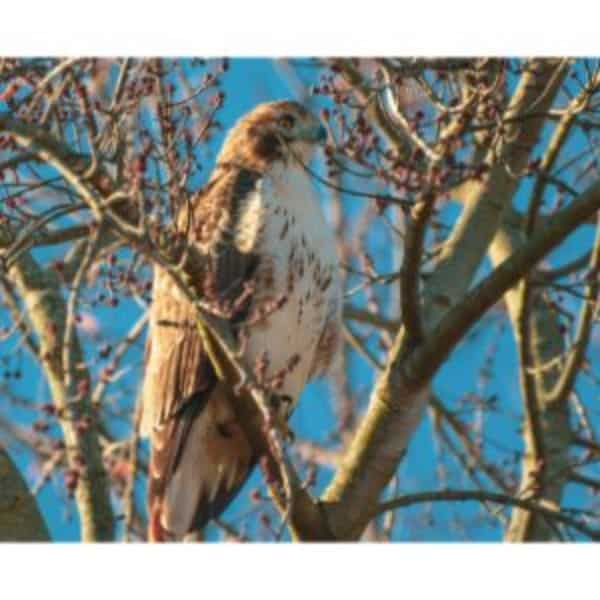
Red-Tailed Hawk Characteristics:
- Scientific Name: Buteo Jamaicensis
- Size: 18 to 26 inches
- Weight: 1.5 to 3.3 pounds
- Wingspan: 3.3 to 4.8 feet
- Life span: 10 to 20 years
- Conservation Status: Least Concern
The Red-Tailed Hawk is one of North America’s more widespread hawk species.
You can easily identify a Red-tailed Hawk by its white breast feathers and trademark scarlet tail.
Red-Tailed Hawks are solitary birds that live in wide spaces and frequently perch on isolated trees.
To impress a female, a male Red-Tailed Hawk will do a show flight that involves making broad circles at a great height.
Although Red-Tailed Hawks can be seen all year in Wisconsin, the winter and summer are the greatest times to watch these raptors.
Early in the morning is the greatest time of day to look for these hawks because they are most likely to take a flight to hunt.
While Red-tailed Hawks have their favorite areas in the state, bird watchers can spot them throughout Wisconsin.
The best places to watch these birds are on the edges of open fields, resting on telephone poles, or in isolated trees.
They are most prevalent in the southern parts of Wisconsin, and this is true both in the summer and the winter.
8. Sharp-Shinned Hawk
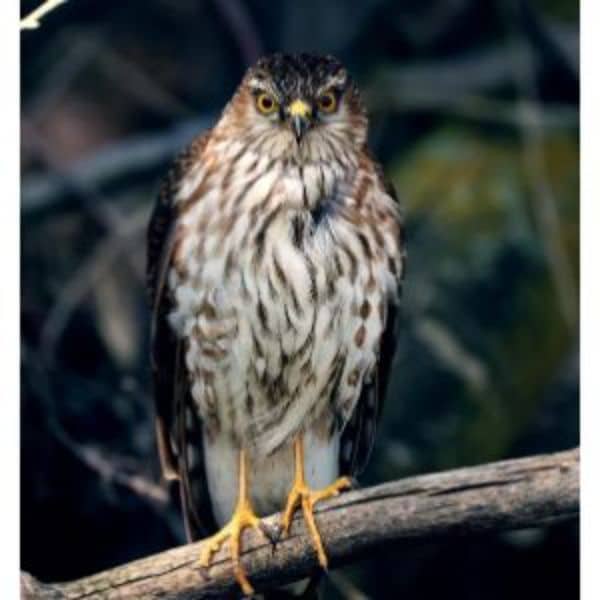
Sharp-Shinned Hawk Characteristics:
- Scientific Name: Accipiter Striatus
- Size: 10 to 14 inches
- Weight: 3.5 to 8.1 ounces
- Wingspan: 17 to 22 inches
- Life span: 5 to 10 years
- Conservation Status: Least Concern
The Sharp-shinned Hawk is the smallest hawk in both Canada and the US.
It can be spotted in Wisconsin and North America all year round.
You can recognize it by its brown and white body feathers, black and brown tail with an alternating band pattern, pale red and white underbelly, and small black beak.
Every year, Sharp-shinned Hawks or Sharpies travel south for the winter and north to breed in Alaska and Canada.
Sharpies can be found in Wisconsin year-round, non-breeding, breeching, and migrating.
As you can see, they are highly migratory birds, but there are a few prime moments each year when you can view them when they travel through your state.
These little hawks have a reputation for observing backyard bird feeders.
If you encounter one, you might want to remove your feeders for a week or two to give the hawk space to find other food.
9. Broad-Winged Hawk
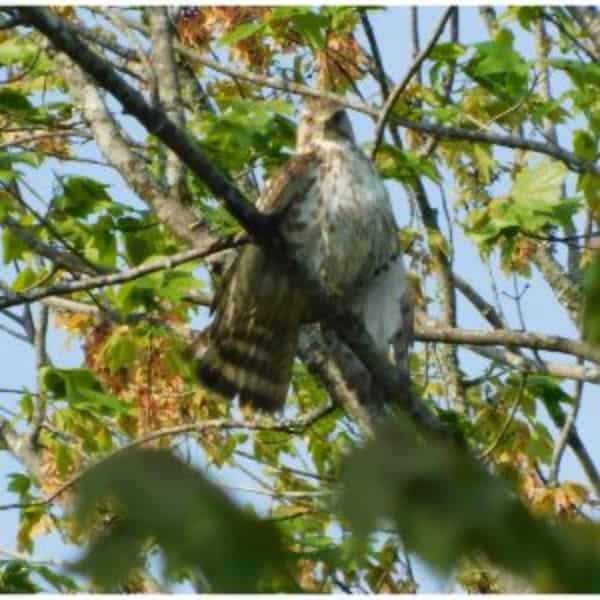
Broad-Winged Hawk Characteristics:
- Scientific Name: Buteo platypterus
- Size: 35-43 cm
- Weight: 280-610 grams
- Wingspan: 74-96 cm
- Life span: 4-5 years
- Conservation Status: Least Concern
Wisconsin is the only state in which the Broad-winged Hawk breeds.
In the fall and the spring of each year, keep an eye out for them around Lake Michigan’s shoreline.
You can identify Broad-winged Hawks by their small size, stocky bodies, and large heads.
They have brown feathers on the top of their body, with bands of dark brown feathers running across them in horizontal stripes.
Their undersides are white with brown horizontal stripes. Moreover, their tails are stripes brown and white.
In flight, you can see a dark brown border on the underside of a Broad-winged hawk’s body.
Their wings come to a point when spread to their full length, and they fly with a flap-flap-glide motion.
Each year, hundreds of Broad-winged Hawks migrate; these enormous flocks are known as “kettles.”
Simply going through a forest in the summer while watching for their piercing whistle is another approach to seeing a Broad-winged Hawk while they are in Wisconsin.
Broad-winged Hawks lay one clutch of 1–5 eggs per year. The male assists the female in building the nest, which is her responsibility.
They will tenaciously defend their nesting area and place their nests at least half a mile from other raptors.
10. Rough-Legged Hawk
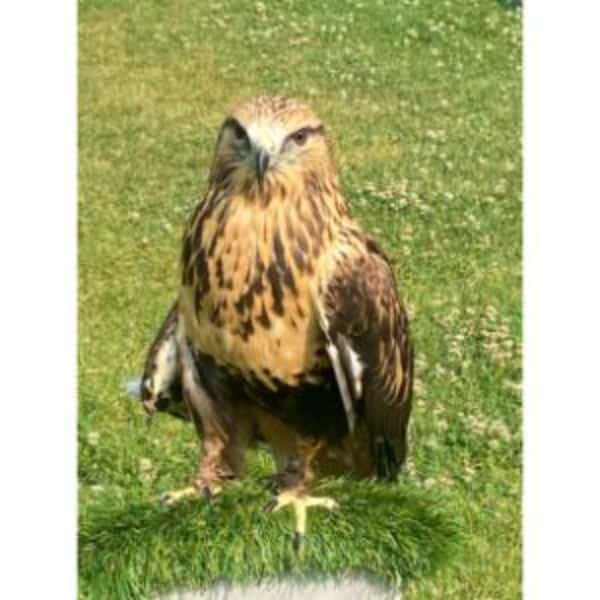
Rough-Legged Hawk Characteristics:
- Scientific Name: Buteo lagopus
- Size: 45-60 cm
- Weight: 600-1,350 grams
- Wingspan: 120-153 cm
- Life span: 8-10 years
- Conservation Status: Least Concern
Only two species of hawks in America have feathered legs all the way down to their toes: Rough-legged Hawks and Ferruginous Hawks.
There are two unique colors for the Rough-legged Hawk: dark morph and light morph. The males’ and females’ plumages are very dissimilar in both morphs.
Dark morphs are a deep chocolate brown hue with two-toned light/dark under their tails and wings, as you might think, and light morphs are often lighter in color with a somewhat speckled pattern.
Birds that migrate include rough-legged hawks.
The greatest time to view one in your state or the rest of the country is now because they spend their winters in Wisconsin and most of the United States.
Each breeding season, they travel a great distance north to the arctic areas of northern Canada and Alaska.
11. Snowy Owl

Snowy Owl Characteristics:
- Scientific Name: Aegolius acadicus
- Size: 7 to 8 inches
- Weight: 2.3 to 5.3 ounces
- Wingspan: 16 to 22 inches
- Life span: 3 to 5 years
- Conservation Status: Least Concern
Our choice for Wisconsin’s most attractive raptor is the Snowy Owl!
Nearly everyone, birders and non-birders alike, are stopped by their magnificent white plumage!
With a height of 20.7-25.2 inches, a wingspan of 48-60 inches, and weights ranging from 3.2-4 lb, this bird is definitely large.
Snowy owls are predominantly white, but all body parts, excluding the breast and face, feature horizontal black lines.
Strangely, Snowy Owls become whiter as they age. Snowy Owls move along with the seasons. They breed in the northern tundra during the summer.
However, these birds migrate south as winter approaches. Snowy Owls rarely venture south of the northern USA during the winter months.
Male Snowy Owls make a loud “hoo, hoo” when protecting their territory or looking for a mate.
This hoot is so aggressive that it may be heard on the tundra from up to 7 kilometers distant! Other sounds (for both sexes) include shrieks, bill snapping, cackles, and hissing.
12. Northern Harrier

Northern Harrier Characteristics:
- Scientific Name: Circus hudsonius
- Size: 41-52 cm
- Weight: 260-530 grams
- Wingspan: 99-122 cm
- Life span: 7 to 10 years
- Conservation Status: Least Concern
The Northern Harrier, a captivating raptor found in the beautiful landscapes of Wisconsin, is a bird of prey that exudes grace and stealth in equal measure.
Also known as the Marsh Hawk, the Northern Harrier’s unique characteristics set it apart from other hawks, making it an intriguing and distinctive species.
With a wingspan of around 99-122 cm (39-48 inches) and a length of approximately 41-52 cm (16-20 inches), the Northern Harrier boasts an impressive size, allowing it to glide and hover over its favored habitats effortlessly.
This remarkable bird’s hunting behavior is equally fascinating.
Taking advantage of its exceptional auditory capabilities and keen eyesight, the Northern Harrier employs a hunting technique called “quartering.”
It glides low over the ground, surveying the terrain for small mammals, birds, and even insects.
Once its prey is spotted, it performs a graceful, aerodynamic maneuver, diving swiftly to capture its target with sharp talons.
During the breeding season, the Northern Harrier constructs its nest on the ground, hidden among tall vegetation, providing a haven for its clutch of eggs.
Migrating from its wintering grounds in southern regions, these harriers return to Wisconsin each spring, adding an element of wonder to the state’s seasonal avian diversity.
13. Osprey
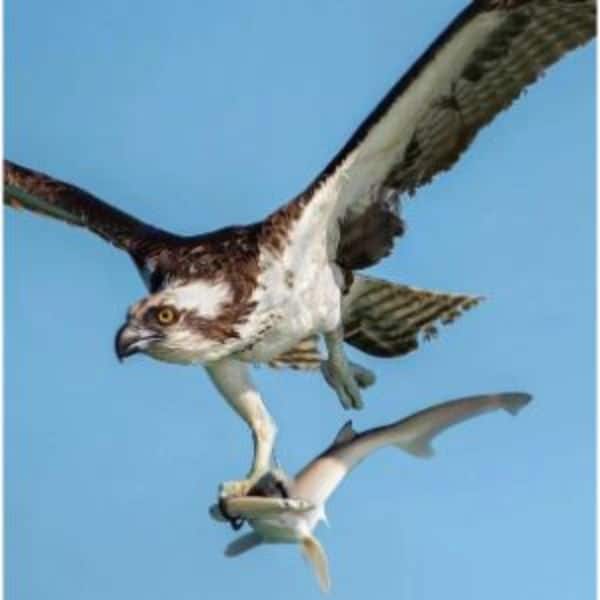
Osprey Characteristics:
- Scientific Name: Pandion Haliaetus
- Size: 21 to 24 inches
- Weight: 3.1 to 4.4 pounds
- Wingspan: 5.9 to 6.6 feet
- Life span: 15 to 20 years
- Conservation Status: Least Concern
The mighty Osprey is the last raptor on our list of 13 birds of prey in Wisconsin.
It can be found along the Atlantic Coast and in areas with strong freshwater and saltwater supplies and is a seasonal visitor to Wisconsin.
Ospreys travel from South America to Canada and back in the fall.
This bird is identifiable by its huge brown body, white head with a prominent brown stripe beginning behind the eye, and black tail.
Brown “wrists” and “fingertips” depicting individual “fingers” are additional field marks.
Their wingbeats are rigid and row-like. Ospreys are skilled fishermen.
They hover above open water before diving feet-first to snag a fish and making a loud splash as they land.
Since they cannot dive deeply and those waters are frequently shallow, they typically catch fish near the surface.
It’s fun to observe an Osprey pair during the breeding season.
They are fascinating to watch, from their complicated courtship practices to the meticulous rebuilding of the nest to nurturing their young.
Birds of Prey in Wisconsin
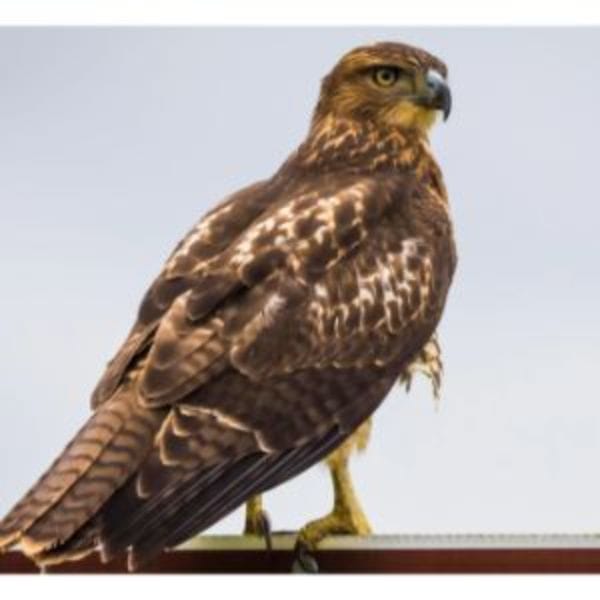
That concludes our list of the 13 most commonly found birds of prey in Wisconsin. These birds all reside in various settings from one another.
For instance, your chances of spotting a Black-Crowned Night-Heron increase if you live close to water.
Take the time to admire the beauty of every bird you see. We hope you liked reading this overview of the most prevalent raptors in Wisconsin.
If you find this guide, “All Birds of Prey in Wisconsin” informative and helpful, you can check out these other bird-related articles from our team:
You can learn more about birds by watching “Bird of Prey” down below:

